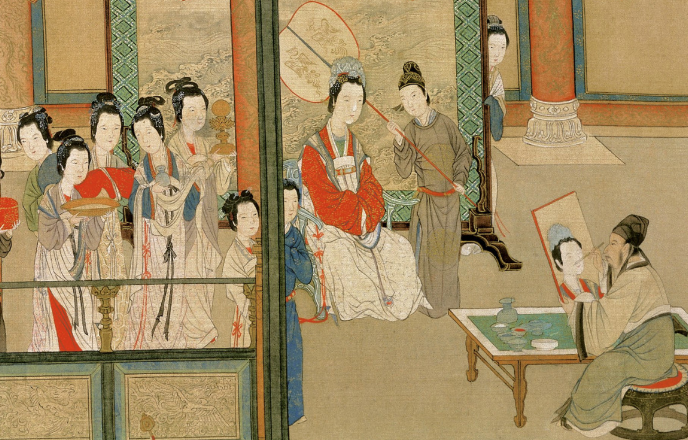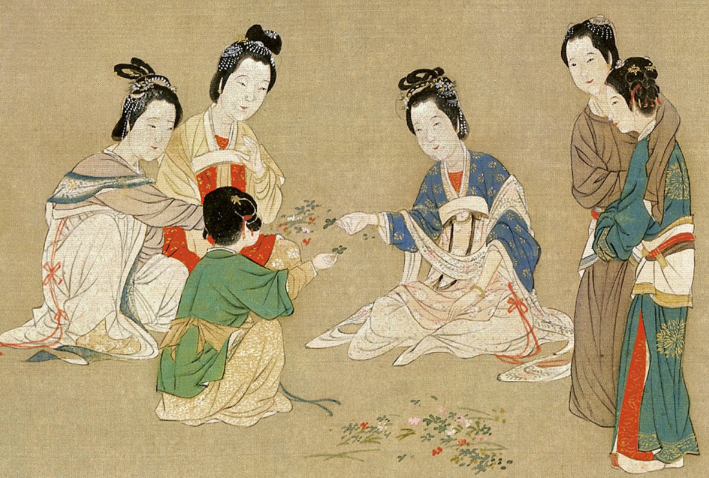Ancient Chinese poets described Hanfu with vivid imagery, symbolizing cultural and social values.
Historical Context of Hanfu in Ancient Chinese Poetry
Emergence and Evolution of Hanfu in Chinese Dynasties
Hanfu, the traditional attire of the Han Chinese, first appeared during the earliest dynastic periods. It evolved significantly across various eras, notably during the Zhou, Qin, and Han dynasties, acquiring unique characteristics in each period. For example, during the Zhou Dynasty, a dual-layered robe called ‘Shenyi’ became prominent. This evolution mirrored the socio-political changes of the times. The Han Dynasty saw the consolidation of Hanfu styles, which later poets would romanticize in their works.

In the Tang Dynasty, Hanfu reached its pinnacle of diversity and richness. This era, often considered a golden age for both Hanfu and poetry, introduced vibrant colors and intricate designs. Research indicates that Tang poets frequently mentioned specific Hanfu styles, like the “Pao,” a long-sleeved robe, symbolizing elegance and nobility. The Song Dynasty, while more conservative, maintained the complexity of Hanfu, with subtler hues and refined patterns.
Ancient poets observed these changes keenly. Their writings not only reflect the aesthetics of the era but also serve as historical records of Hanfu’s evolution. They captured the essence of each period’s Hanfu with remarkable precision and detail, making their works valuable resources for understanding ancient Chinese fashion.
The Role of Hanfu in Ancient Chinese Society and Culture
Hanfu was more than mere clothing; it represented a complex social and cultural tapestry in ancient China. Ancient poets used Hanfu as a symbol to express social status, moral ideals, and even political allegiances. For instance, in the works of poets like Li Bai and Du Fu, the simplicity or opulence of Hanfu often mirrored the wearer’s social position or the broader societal context.
Poets also infused Hanfu with symbolic meanings. For example, a white robe often represented purity and mourning, while bright, luxurious robes could symbolize wealth or a carefree spirit. These symbolic representations found in poetry provide a unique window into the social values and customs of the time. Scholars note that the detailed descriptions of Hanfu in poetry, including references to fabric types like silk and patterns like cloud motifs, reflect the poets’ deep connection with the cultural significance of their attire.
The way poets depicted Hanfu in different contexts highlights the versatility of these garments. In some poems, Hanfu becomes a metaphor for personal emotions or the natural environment, blending human experiences with the cosmic order. This interplay between clothing and environment, as depicted in poetry, underscores the deep philosophical and aesthetic sensibilities of ancient Chinese culture.
Poetic Imagery and Symbolism of Hanfu
Use of Color and Fabric in Describing Hanfu
Ancient Chinese poets meticulously chose colors and fabrics to describe Hanfu, conveying deep emotions and social contexts. For instance, the color red, frequently mentioned in the works of poets like Wang Wei, symbolized joy and prosperity. This color, often found in Hanfu during festive occasions like the Lunar New Year, reflects the cultural significance of red in Chinese society. Similarly, blue and green, prominent in Hanfu during the Tang Dynasty, were not just choices of fashion but also carried connotations of youth and vitality.
The fabric of Hanfu held equal importance in poetic descriptions. Silk, a symbol of luxury and status, appears extensively in Chinese poetry. Poets like Li Qingzhao used silk as a metaphor for delicacy and refinement in their verses. The texture and flow of the fabric in Hanfu, such as the smoothness of silk or the lightness of gauze, were often used to parallel natural elements, like flowing water or drifting clouds, creating a vivid imagery in the reader’s mind.
Symbolic Meanings Attributed to Hanfu in Poetry
Hanfu in ancient Chinese poetry often carried symbolic meanings, transcending its role as mere clothing. For example, a loose-fitting Hanfu could symbolize freedom and a carefree spirit, as seen in Tao Yuanming’s poetry, where he often celebrated a return to nature and simplicity. In contrast, tight or layered Hanfu could reflect societal constraints or the complexity of court life, a theme common in the works of poets from the Tang and Song dynasties.
The state of Hanfu in poems often mirrored the poet’s emotions. Torn or worn-out Hanfu could signify personal turmoil or the decline of moral society, a common theme in the later years of dynasties. On the other hand, well-kept and beautifully adorned Hanfu might symbolize prosperity, peace, or the poet’s longing for a utopian society. These symbolic representations in poetry not only illustrate the poets’ profound emotional connection with Hanfu but also provide a lens through which to view the societal values and cultural ideals of ancient China.
Famous Poets and Their Descriptions of Hanfu
Li Bai Elegance
Li Bai, a celebrated poet of the Tang Dynasty, often depicted Hanfu with an elegant and ethereal quality, seamlessly blending human attire with natural elements. He vividly described flowing robes that seemed to dance with the wind, a metaphor for freedom and transcendence. In one of his renowned poems, he compares the sleeves of a Hanfu to the fluttering wings of birds, a vivid imagery that brings the garment to life. This comparison not only highlights the lightness and grace of the fabric but also Li Bai’s deep appreciation of nature’s beauty, which he often mirrored in his depiction of clothing.
His poems frequently featured Hanfu made of silk, shining under the moonlight, evoking a sense of serenity and otherworldliness. Li Bai’s unique approach to describing Hanfu placed a strong emphasis on harmony between the wearer and the surrounding environment, making his poetry an enchanting blend of fashion and nature.
Du Fu Realism
In contrast to Li Bai’s romanticism, Du Fu, another luminary of the Tang Dynasty, adopted a more realistic approach in his descriptions of Hanfu. His poetry often reflected the social and economic conditions of his time, using clothing as a narrative tool to comment on society. For instance, he described the coarse fabric of the common people’s Hanfu, highlighting the stark contrast between the wealthy and the impoverished. This realistic portrayal not only provided a glimpse into the daily life of different social classes but also served as a subtle critique of societal disparities.
Du Fu’s attention to detail in describing Hanfu was meticulous. He wrote about the patched robes of the poor, a powerful symbol of their struggle and resilience. This focus on the condition and quality of Hanfu in his poems offered a more grounded and human perspective on the lives of everyday people in ancient China, making his work an invaluable resource for understanding the social fabric of his era.

Comparative Analysis of Hanfu Descriptions Across Dynasties
Hanfu in Tang Dynasty Poetry
The Tang Dynasty marked a golden age for Hanfu, reflected vividly in the poetry of that era. Poets like Li Bai and Wang Wei portrayed Hanfu with an emphasis on opulence and elegance. The garments were often described as rich in color, with luxurious fabrics like silk and brocade being the norm. The poetry of this period frequently highlighted the grandeur of court life, with Hanfu serving as a symbol of the dynasty’s wealth and cultural sophistication.
In Tang poetry, Hanfu was more than just clothing; it was a canvas showcasing the artistic and aesthetic zenith of the era. Vivid descriptions of flowing robes, intricate embroideries, and bold colors were common, reflecting the cosmopolitan nature of Tang society. This period’s poetry reveals a fascination with aesthetic beauty and a celebration of artistic expression through clothing.
Shifts in Hanfu Representation from Tang to Song Dynasties
Moving from the Tang to the Song Dynasty, there was a noticeable shift in how poets depicted Hanfu. The extravagant styles of the Tang gave way to a more subdued and refined aesthetic in the Song period. This change is evident in the poetry of Song dynasty poets like Su Shi, who often depicted Hanfu with a focus on simplicity and understatement.
The Song era saw a preference for more muted colors and simpler designs, mirroring the dynasty’s shift towards introspection and moral refinement. While the Tang poets celebrated the splendor of Hanfu, Song poets tended to reflect on the deeper, more introspective qualities of the wearer, using Hanfu as a medium to convey themes of humility, introspection, and a return to traditional values.
The following table provides a comparative analysis of Hanfu descriptions across these two dynasties, highlighting key differences in style, color, fabric, and symbolic representation:
| Aspect | Tang Dynasty | Song Dynasty |
|---|---|---|
| Style | Opulent, luxurious | Subdued, refined |
| Color | Vivid, bold colors | Muted, simpler hues |
| Fabric | Silk, brocade | Lighter, less ornate materials |
| Symbolism | Wealth, grandeur, cosmopolitanism | Humility, introspection, tradition |
This comparative analysis underscores how the portrayal of Hanfu in poetry not only reflects the aesthetic preferences of the time but also mirrors broader societal and cultural shifts between these two pivotal Chinese dynasties.







